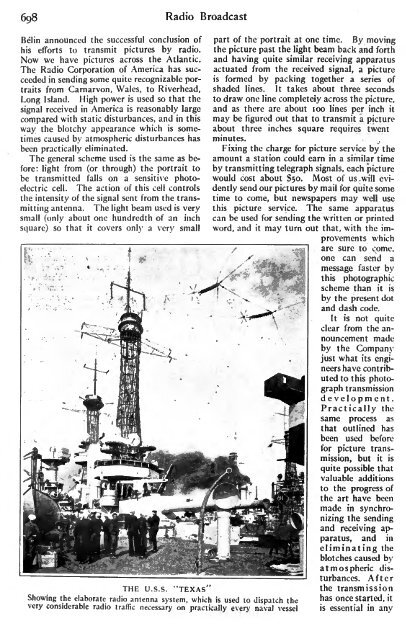Radio Broadcast - 1925, February - 113 Pages ... - VacuumTubeEra
Radio Broadcast - 1925, February - 113 Pages ... - VacuumTubeEra
Radio Broadcast - 1925, February - 113 Pages ... - VacuumTubeEra
Create successful ePaper yourself
Turn your PDF publications into a flip-book with our unique Google optimized e-Paper software.
<strong>Radio</strong><br />
<strong>Broadcast</strong><br />
Belin announced the successful conclusion of<br />
his efforts to transmit pictures by radio.<br />
Now we have pictures across the Atlantic.<br />
The <strong>Radio</strong> Corporation of America has succeeded<br />
in sending some quite recognizable portraits<br />
from Carnarvon, Wales, to Riverhead,<br />
Long Island. High power<br />
is used so that the<br />
signal received in America is reasonably large<br />
compared with static disturbances, and in this<br />
way the blotchy appearance which is sometimes<br />
caused by atmospheric disturbances has<br />
been practically eliminated.<br />
The general scheme used is the same as before:<br />
light from (or through) the portrait to<br />
be transmitted falls on a sensitive photoelectric<br />
cell. The action of this cell controls<br />
the intensity of the signal sent from the transmitting<br />
antenna. The light beam used is very<br />
small (only about one hundredth of an inch<br />
square) so that it covers only a very small<br />
THE u.s.s.<br />
"TEXAS"<br />
Showing the elaborate radio antenna system, which is used to dispatch the<br />
very considerable radio traffic necessary on practically every naval vessel<br />
part of the portrait at one time. By moving<br />
the picture past the light beam back and forth<br />
and having quite similar receiving apparatus<br />
actuated from the received signal, a picture<br />
is formed by packing together a series of<br />
shaded lines. It takes about three seconds<br />
to draw one line completely across the picture,<br />
and as there are about 100 lines per inch it<br />
may be figured out that to transmit a picture<br />
about three inches square requires twent<br />
minutes.<br />
Fixing the charge for picture service by the<br />
amount a station could earn in a similar time<br />
by transmitting telegraph signals, each picture<br />
would cost about $50. Most of us will evidently<br />
send our pictures by mail for quite some<br />
time to come, but newspapers may well use<br />
this picture service. The same apparatus<br />
can be used for sending the written or printed<br />
word, and it may turn out that, with the improvements<br />
which<br />
are sure to come,<br />
one can send a<br />
message faster by<br />
this photographic<br />
scheme than it is.<br />
by the present dot<br />
and dash code.<br />
It is not quite<br />
clear from the announcement<br />
made<br />
by the Company<br />
just what its engineers<br />
have contributed<br />
to this photograph<br />
transmission<br />
development.<br />
Practically the<br />
same process as<br />
that outlined has<br />
been used before<br />
for picture transmission,<br />
but it is<br />
quite possible that<br />
valuable additions<br />
to the progress of<br />
the art have been<br />
made in synchronizing<br />
the sending<br />
and receiving apparatus,<br />
and in<br />
eliminating the<br />
blotches caused by<br />
atmospheric disturbances.<br />
After<br />
the transmission<br />
has once started, it<br />
is essential in anv
















